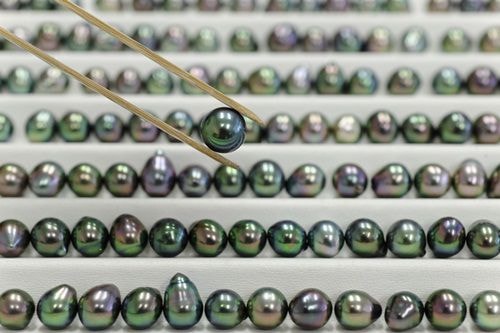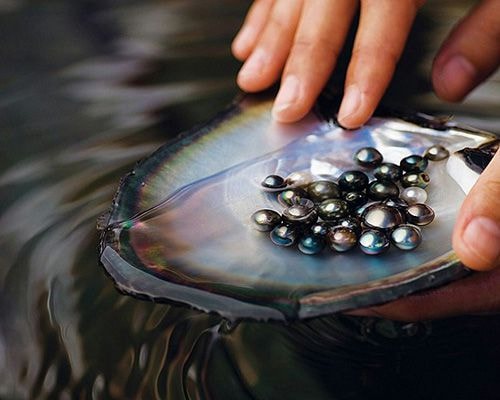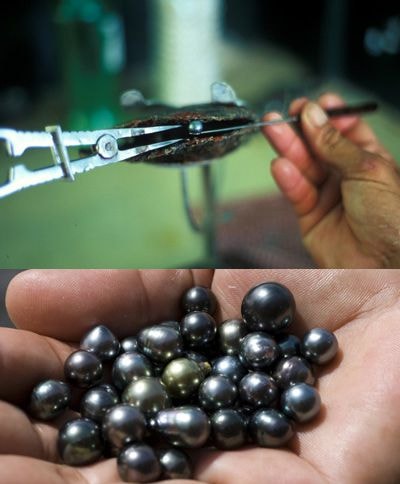Why are Tahitian pearls worth hundreds of thousands of dollars 'favored'?
Unique colors and elaborate crafting process are the factors that help pearls from the French island conquer the sophisticated upper class.
From ancient times to the present, pearls have been the jewelry line chosen by world fashion icons to enhance their class. Famous names such as former US First Lady Jacqueline Kennedy, the legendary Audrey Hepburn and Elizabeth Taylor, Princess Diana or designer Coco Chanel are always associated with pearl necklaces.
Tahitian pearls have been around since the 1970s, and have quickly become a household name. They originate from the French Polynesia islands in the South Pacific. This is one of the few places in the world that can produce the “superb” pearls (the best that can be found anywhere) used in high-end jewelry.
 |
| Tahitian pearls are listed among high-end jewelry lines with classic beauty. |
Naturally formed, rare, with unique colors and meticulous manufacturing process, Tahitian pearls are expensive and sought after by the world's elite.
Tahitian pearls are saltwater pearls that are naturally grown in the pearl shell of the Pinctada margaritifera cumnigi oyster. The five-year cultivation process involves the creation of a pearl by combining polished shell fragments with small pieces of other oyster tissue.
After about 2-3 years, the pearl will be 8-14 mm in diameter with a nacre (pearl component) thickness of 1-2 mm. Large pearls are 16-18 mm in diameter.
To ensure quality, Tahiti has strict regulations on pearl thickness. A pearl that qualifies for export must have a minimum nacre thickness of 0.8 mm, otherwise the durability of the product cannot be guaranteed.
The value of a pearl depends on its size. Pearls are grade A if they are larger than 18mm in diameter, regardless of color. The largest black pearl ever measured was 21mm in diameter, while a baroque (spherical) pearl has a record diameter of 26.9mm. This one is currently on display at the pearl museum in the capital city of Papeete, Tahiti. Experts say that just 1mm increase in diameter can double or triple its value.
Another factor that brings attraction is the diversity and uniqueness of colors that only Tahitian pearls have. With conventional cultured pearls, people have to dye or process the pearl to produce different shades. Tahitian pearls have natural and rare colors without any treatment or impact. This is still a mystery to this day. People speculate that the special colors are due to the different thickness of the nacre layer, the color of the shell fragment used as the core, and the different temperature and quality of the seawater of this island nation.
 |
| The process of cultivating Tahitian pearls is labor-intensive and time-consuming. |
Despite the basic color palette, most Tahitian pearls are famous worldwide for their unique undertone and overtone color that no other pearl growing region can surpass. It is a combination of a spectrum of colors from bluish black (peacock tail), lead gray (coal), silver gray, green, blue, lilac to copper brown, even unique colors such as green gold (pistachio), silver purple (lavender)... shining brightly.
However, the most famous is still the extremely fine black pearl - the type used in most high-end jewelry. 95% of the world's black pearl production is produced here. The legendary black color is thanks to the black inside of the lip oyster - an endemic species that only lives naturally in deep bays of the Polynesian islands.
 |
| The pearls are picked out of the shell. |
The arduous process of raising oysters until they are harvested also contributes to the reputation of Tahitian pearls.
Culturing in the natural environment results in lower yields than normal because the oysters are in poor health and have difficulty surviving. Therefore, the pearl production rate is low, leading to difficulties in mass production. Furthermore, this species also has a higher frequency of eliminating foreign objects from the body than other oyster species (up to 50%, according to the Gemological Institute of America), making the implantation of the nucleus even more difficult.
A GIA statistic proves that the rarity of Tahitian black pearls is so high that only 1-2% of the pearls collected are perfectly round. At the same time, it takes an average of 1,000 pearls to be mined to be able to find eight pearls that are highly similar in color, shape, and size to make a pair of earrings.
Thanks to their unparalleled "exclusive" qualities, black pearls are favored by the fashion industry, the upper class, and politicians. The economic benefits from pearls in general and black pearls in particular for the island nation of Tahiti are so great that they are second only to the tourism industry. A 10-14 mm Tahitian pearl necklace today costs up to 30,000-40,000 USD (700-900 million VND). Meanwhile, a three-ring necklace with 12-15 mm pearls cost 880,000 USD in the 1980s (about 56 billion VND today).
 |
| Many beauties and fashion icons in the world are willing to spend large sums of money to wear pearl necklaces from the French island. From left to right: Danish Princess Mary, Keira Knightley, Angelina Jolie. |
For decades, Tahitian black pearls have been the top choice for creating a noble, luxurious and mysterious style for women. This pearl line is suitable for all skin tones and body shapes, helping women shine wherever they appear. That is the reason why movie stars and celebrities such as Angelina Jolie, Sharon Stone, Oprah Winfrey, Keira Knightley... choose black pearl jewelry for their public appearances. A typical example is "British rose" Keira Knightley. She chose to wear a Tahitian pearl choker (close to the neck) when she debuted the movie Pirates of the Caribbean: The Curse of the Black Pearl in 2003.
Not only the entertainment industry, royalty and politicians also collect this jewelry. From the Queen of England, Queen Maxima of the Netherlands, Mrs. Obama, Kennedy to Princess Mary of Denmark, Princess Anne of England... all own a collection of necklaces, rings, and earrings made from precious Tahitian black pearls.
According to Vnexpress
| RELATED NEWS |
|---|


